One of the most promising coaches in European football, Julian Nagelsmann will continue his development with RB Leipzig. Having been in charge of Hoffenheim since 2016, the move represents a logical progression for the 32-year-old.
Red Bull finished third in the 2018/19 Bundesliga season, sealing Champions League football for the 2nd time in their 10 year existence. This tactical analysis will examine Leipzig’s pre-season performances and assess their tactics ahead of the new campaign.
Squad changes and possible line-up
As was typically the case at his previous club, Nagelsmann has stuck with his preferred formation of 3-3-2-2/3-1-4-2. With that said, the attacking box has shown fluidity and dynamism, as we will see later in this analysis.
Talented young defender Ibrahima Konate appears to be the favoured choice at the centre of the back three, playing the role of ‘quarterback’. Dayot Upamecano is expected to line up to one side of him, while Nordi Mukiele and Willi Orban are likely to compete for the remaining spot. Marcel Halstenberg and Konrad Laimer are perhaps best placed to start as the wing-backs, but Lukas Klostermann and Marcelo Saracchi represent viable alternatives.
Former Liverpool goalkeeper Peter Gulacsi is almost certain to retain his place between the sticks. At the base of midfield, Diego Demme will need to hold off competition from USA international Tyler Adams. Chelsea loanee Ethan Ampadu has the capacity to provide cover across the back-line, as well in the pivot role.
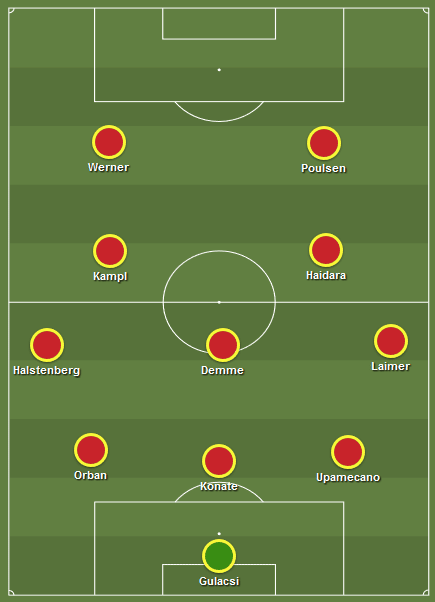
Perhaps the least certainty exists over who will play in the two attacking midfield positions, with many quality options to choose from. Amadou Haidara will begin his first full term in Germany having followed the much-travelled path from RB Salzburg. Christopher Nkunku arrives from PSG, and Kevin Kampl remains a reliable and experienced member of the squad. Marcel Sabitzer and Stefan Ilsanker will add further depth in this department, with Emile Forsberg’s future up in the air heading into the final weeks of the transfer window.
Timo Werner is expected to join Yussuf Poulsen up-front, while Ademola Lookman has returned on a permanent basis following an impressive loan spell 2018. Jean-Kevin Augustin, Matheus Cunha, and Hannes Wolf will complete the supporting cast in attack, although the latter will begin the campaign on the treatment table having broken his ankle in June.
Attacking patterns
Leipzig have mainly formed a base shape of 3-3-2-2 in their preperations for the new season. However, as shown by the first image below, the wing-backs look to advance and join the third and fourth lines depending on the situation.
During established attacking phases, the back three focus on circulating possession while the central players ahead of them move dynamically to occupy space. When sufficient gaps exist in the opponent’s structure, the centre-backs can feed the midfield line and allow them to link up with the strikers or supply the wing-backs.
Meanwhile, if the midfielders are occupied, they will often move to drag their opponents away from the centre. This strategy has the potential to open direct passing lanes through to the attack. When the opposition focuses on controlling the centre, Leipzig’s defenders will allow the wing-back to progress the play via the channels. The image below illustrates their standard attacking shape with possession on the first line.
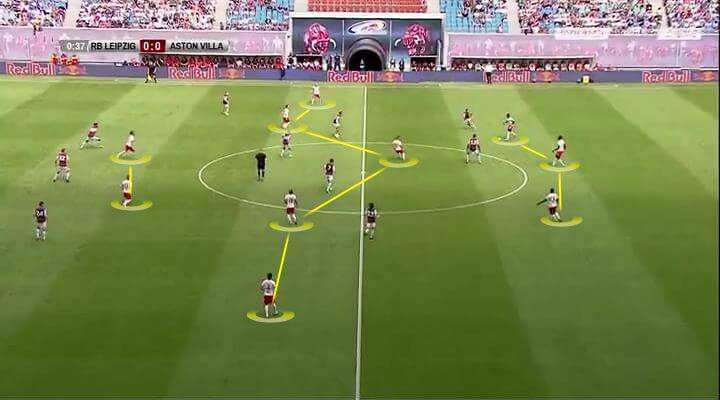
During the first-phase, Konate has often moved forward to create a diamond structure. It has been somewhat of a surprise to see him there, despite his obvious technical prowess. Upamecano has experienced playing in midfield before, and so might have been a more likely candidate to occupy the fluid central role in Nagelsmann’s back line.
The next image shows an example of this layout, with RB enjoying a 4 v 3 advantage in the build-up. Furthermore, the strategy allows the holding midfielder and the wing-backs to position themselves behind the opponent’s first line of pressure. Gulacsi tries to exploit this with a lofted ball towards Saracchi on the left, but he fails to execute the pass on this occasion and the ball runs out for an Aston Villa throw-in.
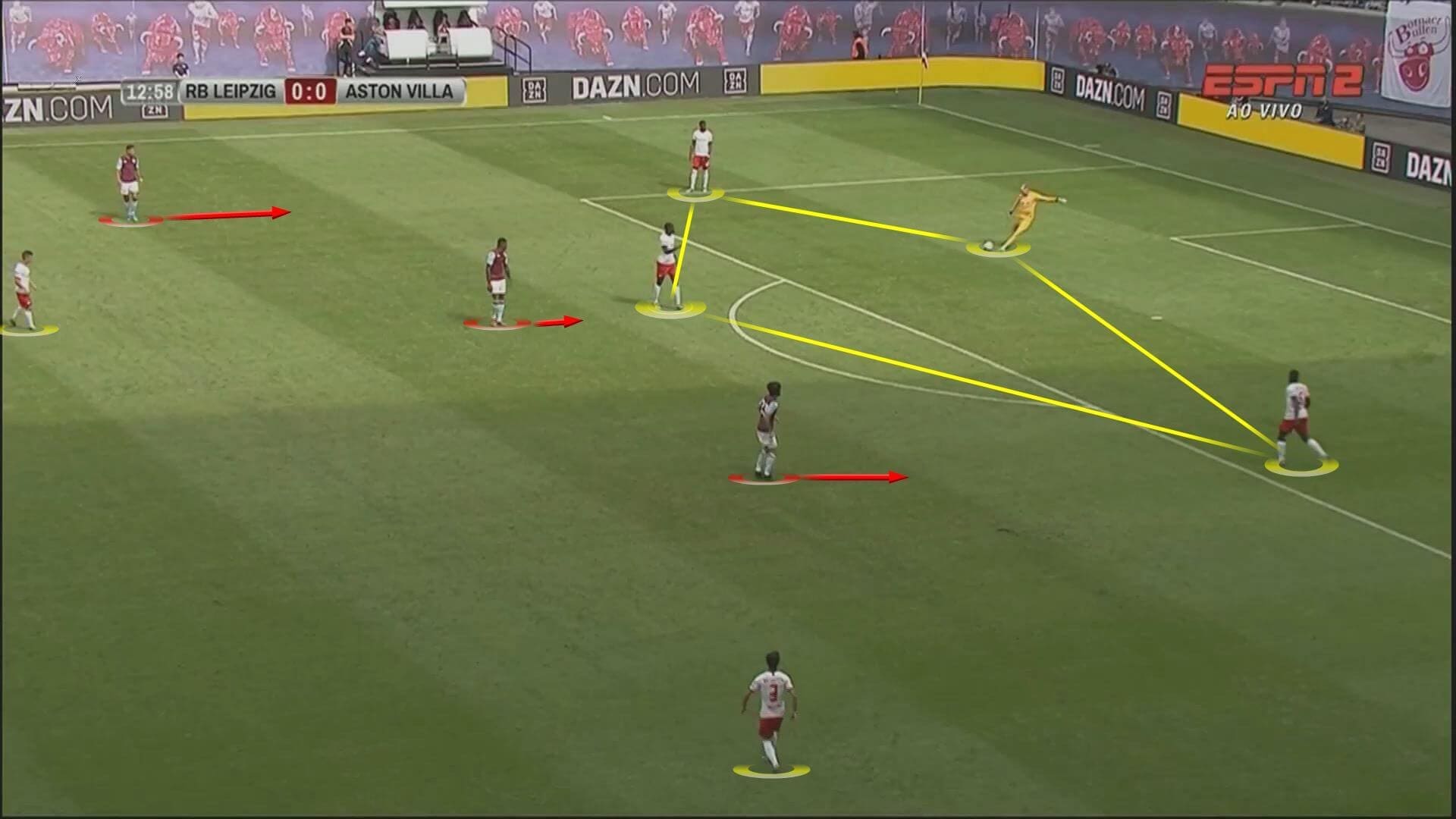
When the opposition plays with a narrow midfield line during their defensive phase, Leipzig have a variety of tools to take full advantage. Upamecano and Mukiele have shown the capacity to progress the play with dribbles down the sides, while Konate also has excellent ball-carrying ability.
Another trick they use to exploit narrow spacing involves an attacking player dropping into the deep half-space to receive before driving into the final third with the ball at their feet. Werner has displayed the skill set required to contribute in this sense, while the wing-backs and attacking midfielders are also capable alternatives.
In the image below, Werner has withdrawn from the attack to take possession in the left half-space. Supporting the move further, Demme engages an opponent in order to clear the passing lane for Konate.
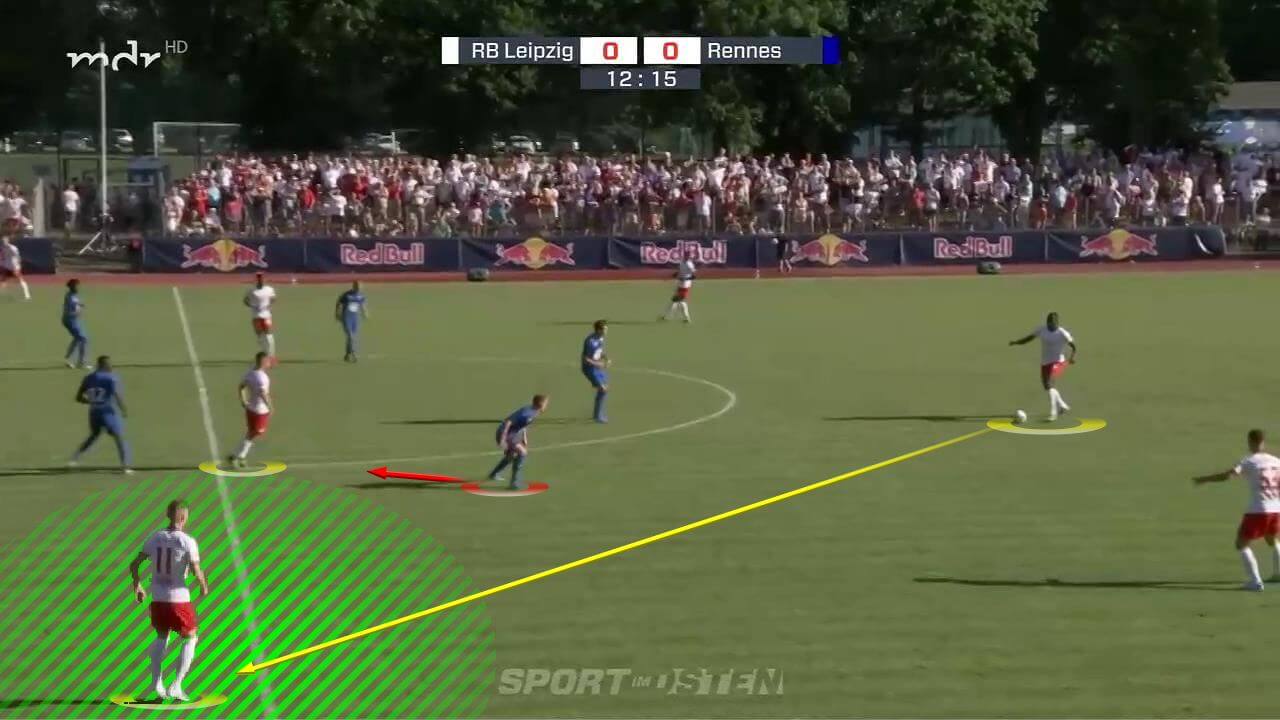
Werner dribbles at speed into the attacking third, inviting pressure from multiple Rennes players. In moments where space exists to combine in central areas, the German international will do so. In this scenario, space is out-wide, allowing Halstenberg to arrive on the overlap and deliver a cross.
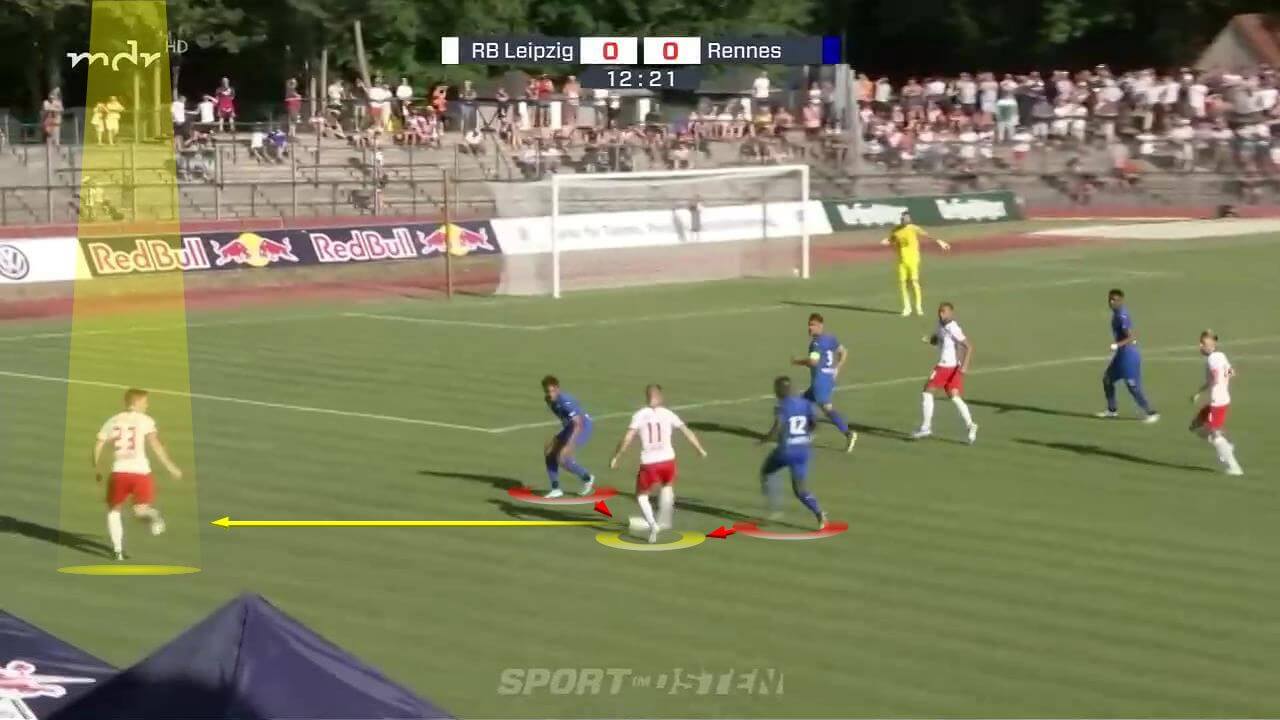
Leipzig’s use of rotations as a way to create progressions has also been interesting. As we saw in the previous sequence, the left-striker had dropped into a left of central midfield role. Meanwhile, when one of the centre-backs pushes forward, Demme will sometimes drop into the backline to receive as the free man.
On other occasions, the wingback will move infield and swap positions with the same-sided attacking midfielder. This specific rotation is illustrated by the analysis image below, as Kampl lines up on the left-wing. Halstenberger drifts into a more central role, running in behind to receive from Kampl before playing a cut-back across the face of goal.
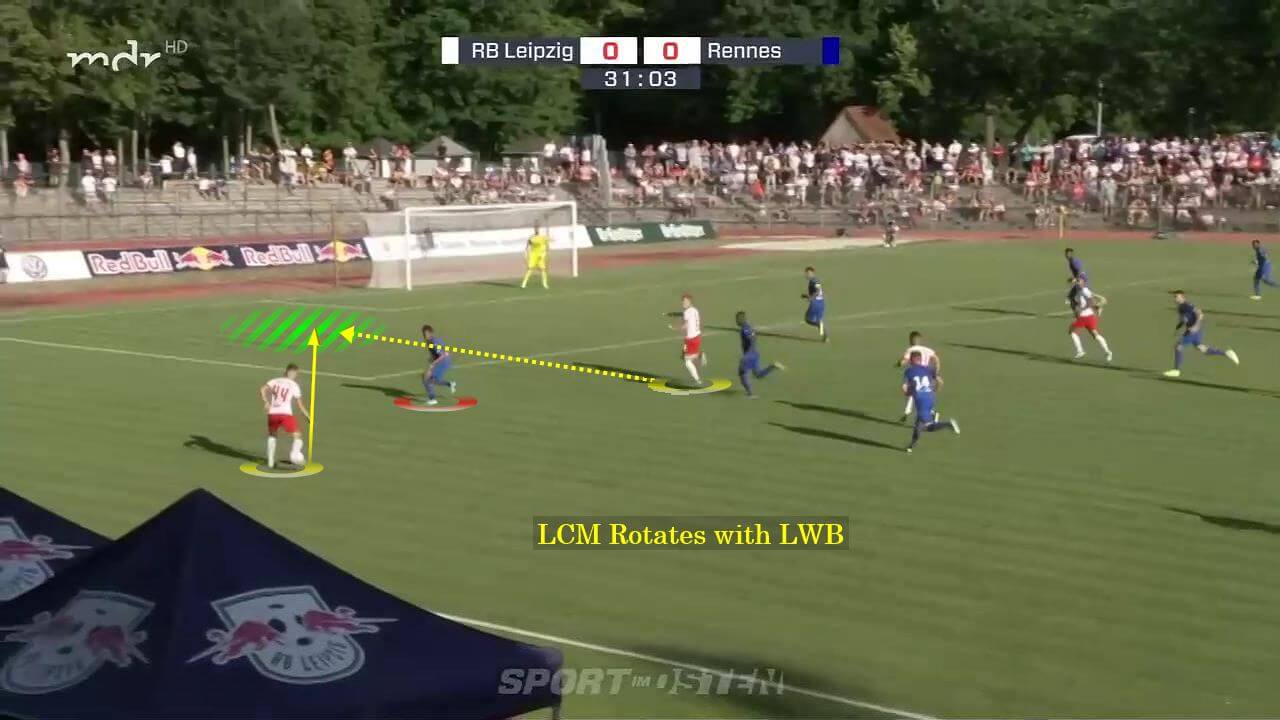
So far, we have seen how Nagelsmann’s team attacks down the wide channels. Where possible, they also look to penatrate the opponent’s defensive lines centrally. As shown by the previous examples, this isn’t always easy to acheive when their rivals congest the centre. However, there are a number of strategies that Leipzig implement in order to overcome this barrier.
As discussed earlier, RB’s centre-backs have exceptional line-breaking abilities. Each of Konate, Upamecano, and Mukiele have the capacity to progress the play using passes or dribbles. Oftentimes, they will carry the ball towards an opposition player, inviting pressure and opening up space behind him in the process. Alternatively, they look to shift opponents with misleading body shape, before playing reverse passes to exploit the newly opened lane.
This can be seen in the next example, with Mukiele shaping to feed Poulsen in the right forward position. A Villa midfielder responds to this implied action by moving across to intercept. However, Mukiele reverses the pass to Werner at the last second.
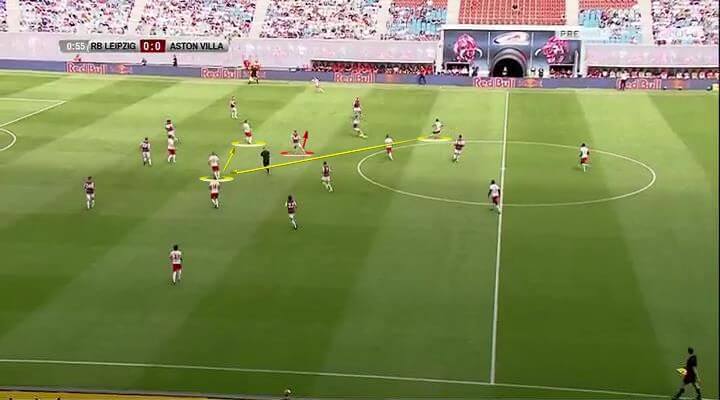
Werner attempts a first time lay-off towards Poulsen, but the 23-year-old fails to execute the pass and the move breaks down. At Hoffenheim, Nagelsmann’s centre-backs often played incisive wall-passes off the strikers, allowing the surrounding attackers to receive facing the play and behind the opponent’s defensive lines. This strategy for breaking through in central areas has already been tested at Leipzig. However, the same success hasn’t been enjoyed so far. Poulsen has typically been the target, but his loose touch has seen the tactic fail more often than not.
Another noteworthy aspect of their attacking play ahead of the new season has seen them excel in transitional moments. When the opposition are forced to go long on goal-kicks, Red Bull are adept at winning the first and second balls with a high volume of players in central areas. In these scenarios, there is typically lots of space to exploit in behind, allowing them to make use of Werner’s pace with instant through balls.
These opportunities have also presented themselves on occasions when their own build-up has broken down. The example below highlights this, with RB attacking quickly in a moment of disorganisation for the opponents.
After Konate had conceded possession with a misplaced pass, the German side pressed aggressively to recover the ball just as Rennes were transitioning into their attack. Kampl exploits the chaos with a pass in behind for Werner to run onto before the opposing goalkeeper rushes out to end the threat.
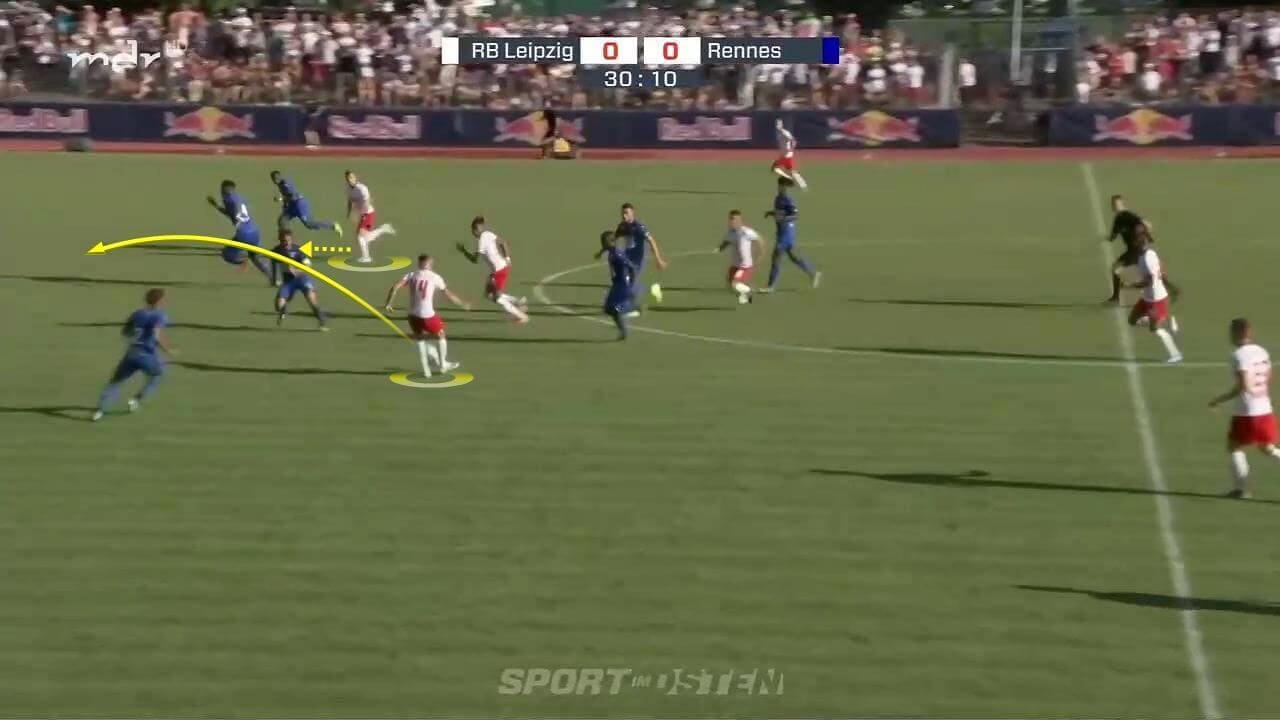
Overall, Nagelsmann still has work to do before this Leipzig team will be singing to his tune. As we’ve seen, they have had issues with progressing the play via the centre, often failing to execute basic wall-passes and decoy movements. In general, their combination play in the final third is an area where significant improvements are needed.
However, there have also been plenty of positives. Konate, Mukiele, and Upamecano have the potential to become a formidable line-breaking trio, while Werner’s ability to drop off and carry the play forward is also promising.
Defensive set-up
Without the ball, they have typically applied measured pressure. Much of their opponent’s goal-kicks have been forced long due to intelligent coverage from the Red Bull attackers.
This is highlighted by the first image below, with Leipzig forming a pentagon shape in the opposition half. The strikers form the first line of pressure, while the midfield support from behind. On this occasion, Rennes avoid the risk of building out from the back and instead play a hopeful long ball.
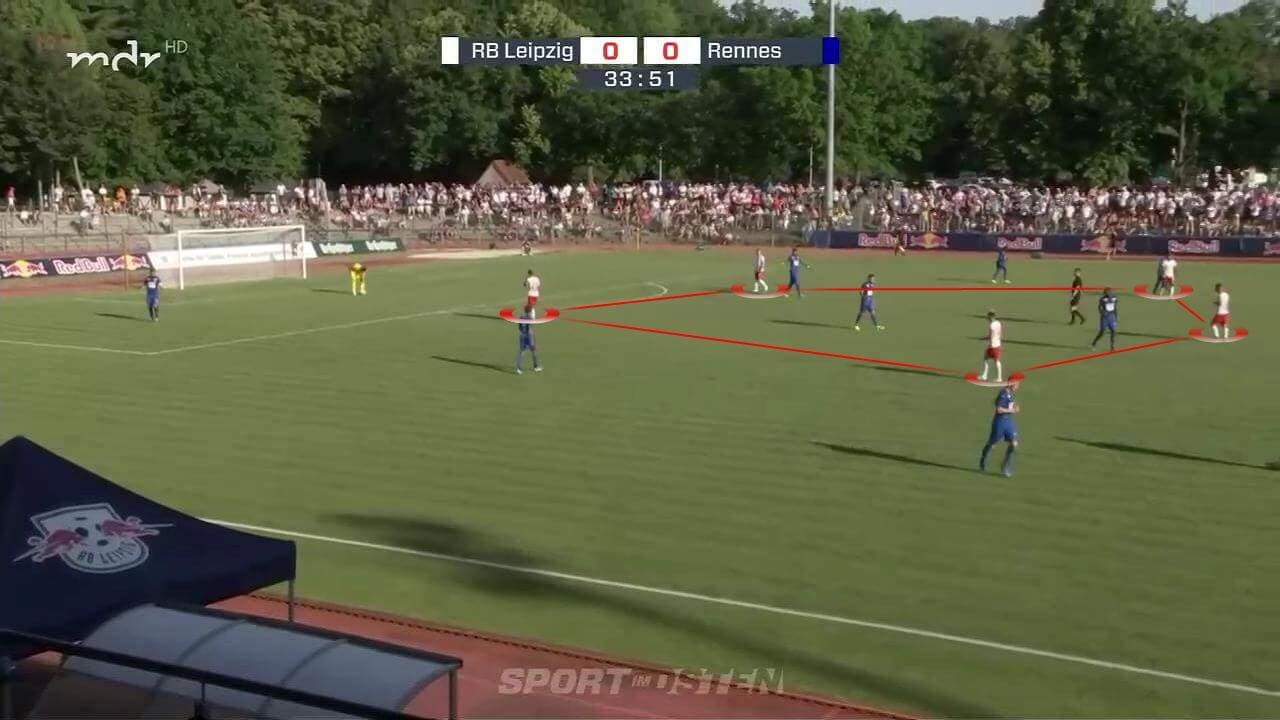
With Nagelsmann’s side lining up with a narrow attack, the focus when pressing is to direct the opposition down the flanks. From here, the ball-near wing-back, attacking midfielder and striker combine to apply intense pressure against the touchline.
As the wing-back pushes up in these instances, the last line becomes a back four, while the far-sided attacking midfielder joins the holding player to cover the ten space. We see this type of structure at it’s most organised when the opponents have a throw-in beyond the half-way line.
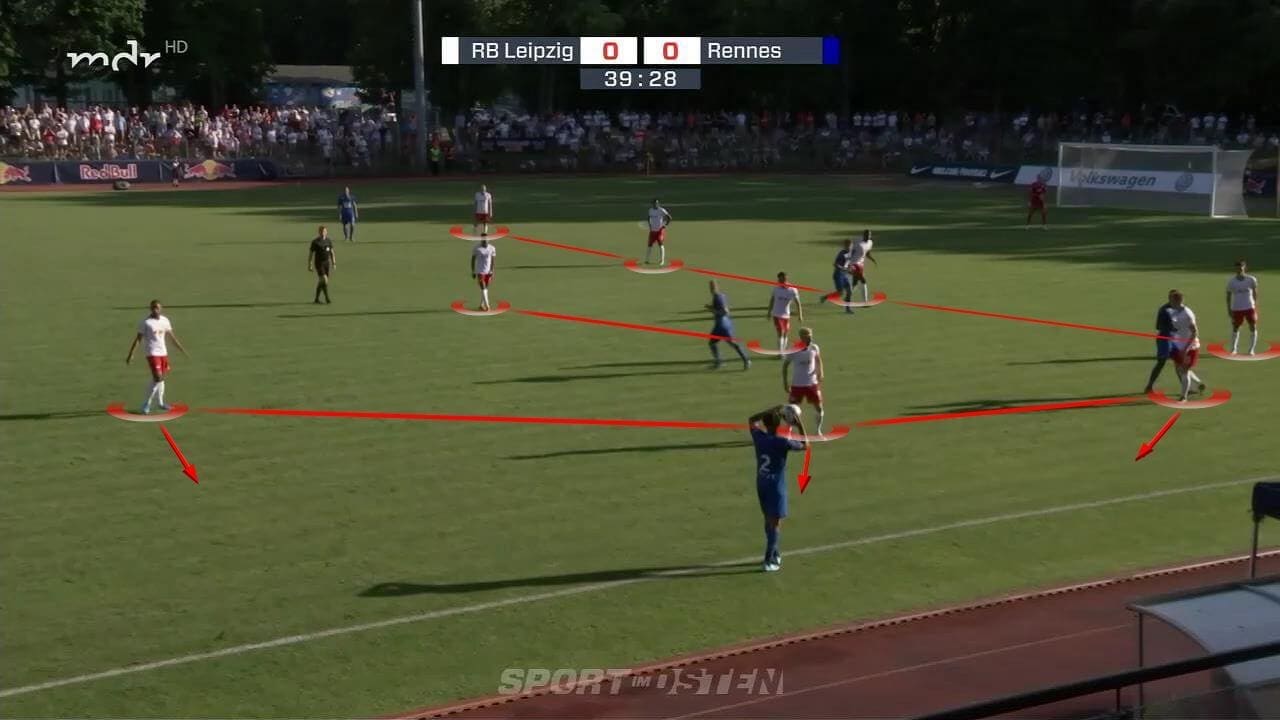
When the opposition have the ball in central areas, RB’s formation resembles more of a 3-5-2. The next analysis image shows this, as Villa begin to move the play down the sides. As we can see, there are spaces to exploit either side of the back three if the opponents choose to attack quickly.
This was also an issue for much of Nagelsmann’s time at Hoffenheim, exploited perfectly by Jurgen Klopp’s Liverpool in their 2017 Champions League qualifier at Anfield. In the sequence shown below, Frederic Guilbert plays a direct ball towards the strikers. Caught wrong-side and isolated against Wesley Moraes, Mukiele gives away a foul on the edge of the penalty area. The resulting free-kick saw Conor Hourihane put the visitors in front.
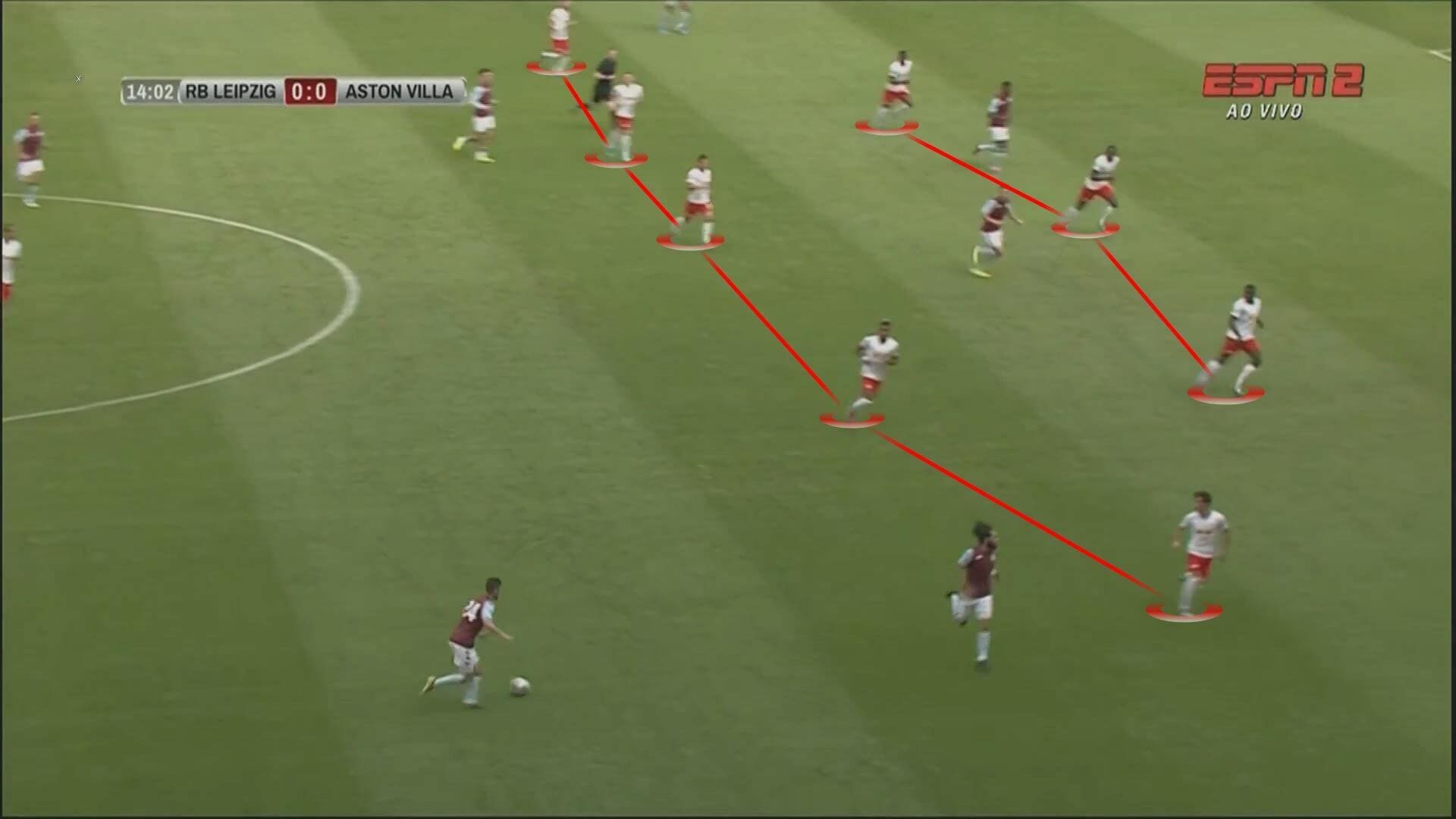
With the wing-backs positioned so high, Leipzig’s back three consistently found themselves exposed against Villa. The previous example shows how this weakness can be exploited when they are organised in 3-5-2 without the ball. Meanwhile, Red Bull’s transition between attack and defence can be targeted in a similar fashion.
In the final example, Upamecano had given the ball away during the build-up. The English side immediately looked to exploit the space to his left with a quick ball into the channel for Guilbert to chase. Ultimately, Villa failed to capitalise on this occasion with Konate making a covering run to make up for his teammates’ mistake.
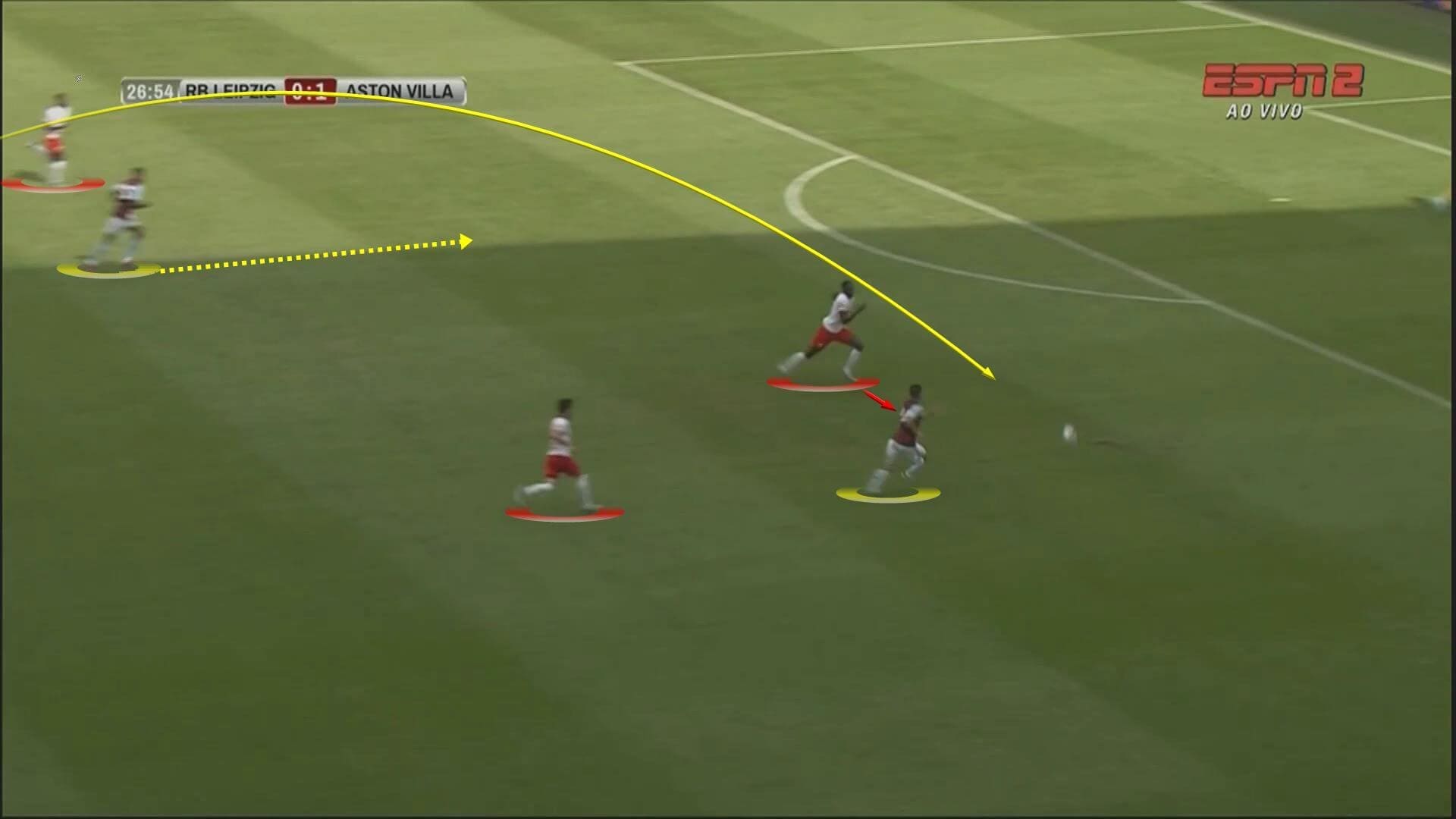
Overall, Nagelsmann’s team should be well organised this season in the out-of-possession phases. However, Hoffenheim’s difficulty in covering the spaces behind their wing-backs appears to have carried over. The narrow back three are too often left isolated and opponents consistently succeed in exploiting the channels alongside them. Solving this problem will be crucial to their hopes of competing at the top end of the Bundesliga this term.
Conclusion
As shown by this scout report, Julian Nagelsmann’s RB Leipzig have displayed signs of promise during pre-season, with some interesting concepts being implemented. However, comfortable losses to Aston Villa and FC Zurich should temper expectations slightly.
Although friendly games are primarily about testing systems and strategies, as well as building up match-fitness, those defeats have highlighted some flaws that will need to be ironed out quickly. Nagelsmann is a young and talented coach, still with plenty of room to improve. The same can be said for much of his new playing squad, and it will be intriguing to follow their development at the Red Bull Arena in the coming months.
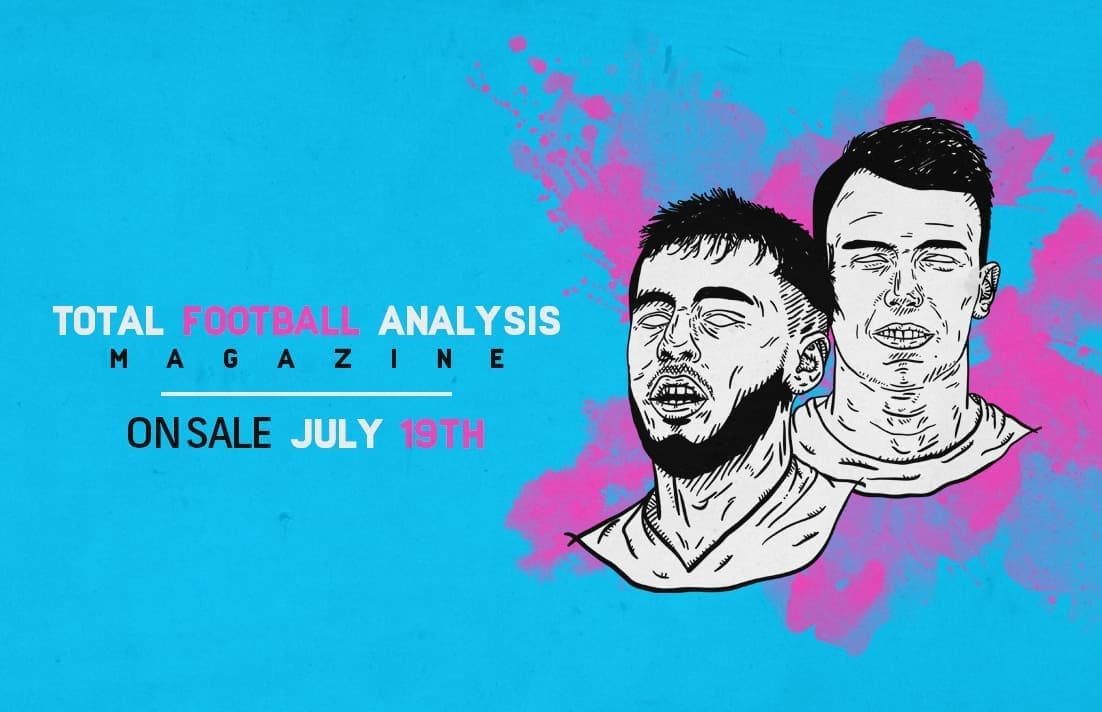
If you love tactical analysis, then you’ll love the digital magazines from totalfootballanalysis.com – a guaranteed 100+ pages of pure tactical analysis covering topics from the Premier League, Serie A, La Liga, Bundesliga and many, many more. Buy your copy of the July issue for just ₤4.99 here, or even better sign up for a ₤50 annual membership (12 monthly issues plus the annual review) right here.

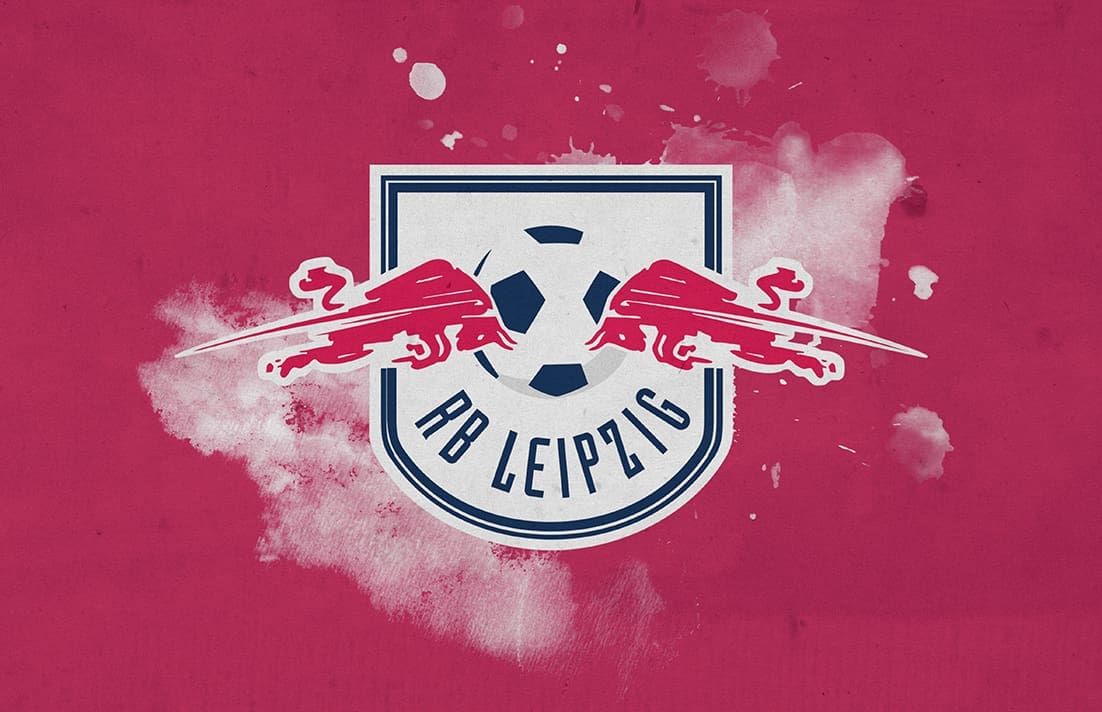




Comments